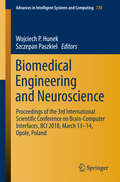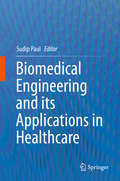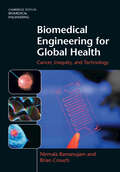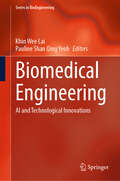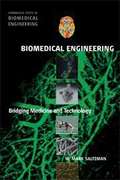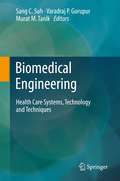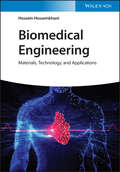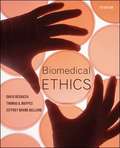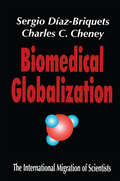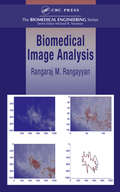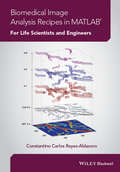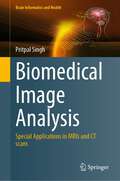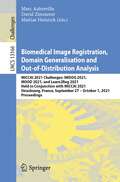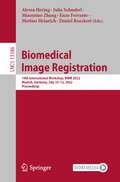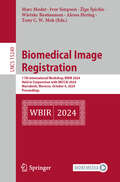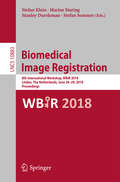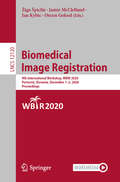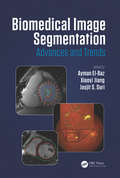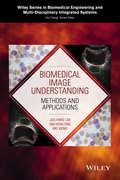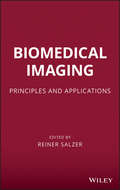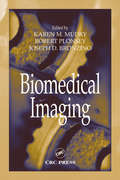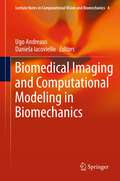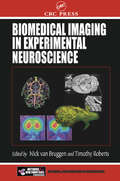- Table View
- List View
Biomedical Engineering and Neuroscience: Proceedings Of The 3rd International Scientific Conference On Brain-computer Interfaces, Bci 2018, March 13-14, Opole, Poland (Advances In Intelligent Systems And Computing #720)
by Wojciech P. Hunek Szczepan PaszkielThis edition of the volume ‘Advances in Intelligent Systems and Computing’ presents the proceedings of the 3rd International Scientific Conference BCI. The event was held at Opole University of Technology in Poland on 13 and 14 March 2018. Since 2014 the conference has taken place every two years at the University’s Faculty of Electrical Engineering, Automatic Control and Informatics. The conference focused on the issues relating to new trends in modern brain–computer interfaces (BCI) and control engineering, including neurobiology–neurosurgery, cognitive science–bioethics, biophysics–biochemistry, modeling–neuroinformatics, BCI technology, biomedical engineering, control and robotics, computer engineering and neurorehabilitation–biofeedback.In addition to paper presentations, the scientific program also included a number of practical demonstrations covering, for example, the on-line control of mobile robot and unmanned aerial vehicle using the BCI technology.
Biomedical Engineering and its Applications in Healthcare
by Sudip PaulThis book illustrates the significance of biomedical engineering in modern healthcare systems. Biomedical engineering plays an important role in a range of areas, from diagnosis and analysis to treatment and recovery and has entered the public consciousness through the proliferation of implantable medical devices, such as pacemakers and artificial hips, as well as the more futuristic technologies such as stem cell engineering and 3-D printing of biological organs. Starting with an introduction to biomedical engineering, the book then discusses various tools and techniques for medical diagnostics and treatment and recent advances. It also provides comprehensive and integrated information on rehabilitation engineering, including the design of artificial body parts, and the underlying principles, and standards. It also presents a conceptual framework to clarify the relationship between ethical policies in medical practice and philosophical moral reasoning. Lastly, the book highlights a number of challenges associated with modern healthcare technologies.
Biomedical Engineering for Global Health
by Rebecca Richards-KortumCan technology and innovation transform world health? Connecting undergraduate students with global problems, Rebecca Richard-Kortum examines the interplay between biomedical technology design and the medical, regulatory, economic, social and ethical issues surrounding global health. Driven by case studies, including cancer screening, imaging technologies, implantable devices and vaccines, students learn how the complexities and variation across the globe affect the design of devices and therapies. A wealth of learning features, including classroom activities, project assignments, homework problems and weblinks within the book and online, provide a full teaching package. For visionary general science and biomedical engineering courses, this book will inspire students to engage in solving global issues that face us all.
Biomedical Engineering for Global Health: Cancer, Inequity, and Technology (Cambridge Texts in Biomedical Engineering)
by Nirmala Ramanujam Brian CrouchExplore the fundamentals of biomedical engineering technologies with this thought-provoking introduction, framed around modern-day global cancer inequities. Connecting engineering principles to real-world global health scenarios, this textbook introduces major technological advances in cancer care through the lens of global health inequity, discusses how promising new technologies can address this inequity, and demonstrates how novel medical technologies are adopted for real-world clinical use. It includes modular chapters designed to enable a flexible pathway through material, for students from a wide range of backgrounds; boxed discussion of contemporary issues in engineering for global health, encouraging students to explore ethical questions related to science and society; supplementary lab modules for hands-on experience in translating engineering principles into healthcare solutions; and over 200 end-of-chapter problems, targeting multiple learning outcomes to solidify student understanding. This introduction is designed to equip students with all the critical, technical, and ethical knowledge they need to excel.
Biomedical Engineering: AI and Technological Innovations (Series in BioEngineering)
by Khin Wee Lai Pauline Shan Qing YeohThis book brings together contributions from leading experts in the field, each addressing a critical area where AI and technology are making significant impacts. The chapters encompass a wide range of topics, from the application of machine learning in cancer grading and maternal health monitoring to the development of innovative wearable devices and advanced diagnostic tools. The book not only underscores the transformative potential of AI and technology in biomedical; but also serves as a vital resource for researchers, practitioners, and students. By showcasing the latest research and innovations, this book aims to inspire continued exploration and development in this dynamic and rapidly evolving field.
Biomedical Engineering: Bridging Medicine and Technology
by W. Mark SaltzmanThis book is an introduction to biomedical engineering, starting from the basics and demonstrating the engineering principles that are used to create new diagnostic methods and therapies for human disease. Although biomedical engineering is a relatively new field of study, it will impact almost every person in the world.
Biomedical Engineering: Health Care Systems, Technology and Techniques
by Sang C. Suh Varadraj Gurupur Murat M. TanikBiomedical Engineering: Health Care Systems, Technology and Techniques is an edited volume with contributions from world experts. It provides readers with unique contributions related to current research and future healthcare systems. Practitioners and researchers focused on computer science, bioinformatics, engineering and medicine will find this book a valuable reference.
Biomedical Engineering: Materials, Technology, and Applications
by Hossein HosseinkhaniBiomedical Engineering An exploration of materials processing and engineering technology across a wide range of medical applications The field of biomedical engineering has played a vital role in the progression of medical development technology. Biomedical Engineering: Materials, Technology, and Applications covers key aspects of the field—from basic concepts to advanced level research for medical applications. The book stands as a source of inspiration for research on materials as well as their development and practical application within specialized industries. It begins with a discussion of what biomedical engineering is and concludes with a final chapter on the advancements of biomaterials technology in medicine. Offers comprehensive coverage of topics, including biomaterials, tissue engineering, bioreceptor interactions, and various medical applications Discusses applications in critical industries such as biomedical diagnosis, pharmaceutics, drug delivery, cancer detection, and more Serves as a reference for those in scientific, medical, and academic fields Biomedical Engineering takes an interdisciplinary look at how biomedical science and engineering technology are integral to developing novel approaches to major problems, such as those associated with disease diagnosis and drug delivery. By covering a full range of materials processing and technology-related subjects, it shares timely information for biotechnologists, material scientists, biophysicists, chemists, bioengineers, nanotechnologists, and medical researchers.
Biomedical Ethics (Seventh Edition)
by David Degrazia Thomas Mappes Jeffrey BallardThis best-selling anthology of readings with case studies provides insightful and comprehensive treatment of ethical issues in medicine. Appropriate for courses taught in philosophy departments, bioethics programs, as well as schools of medicine and nursing, the collection covers such provocative topics as biomedical enhancement, clinical trials in developing countries, animal research, physician-assisted suicide, and health care reform. The text's effective pedagogical features include chapter introductions, argument sketches, explanations of medical terms, headnotes, and annotated bibliographies.
Biomedical Globalization: The International Migration of Scientists
by Charles CheneyDespite much debate in recent years about the economic and professional impact of foreign engineers and computer professionals in the United States, comparatively little has been said about the growing number of foreign biomedical scientists employed by American firms and health institutions. The implications are widespread and merit serious analysis. In Biomedical Globalization, Sergio Diaz-Briquets and Charles C. Cheney shed light on this development through examination of the experience of foreign biomedical scientists at the National Institutes of Health (NIH) in Bethesda, Maryland.Diaz-Briquets and Cheney's analysis is based on results of ethnographic field observations and more than 200 interviews among diverse biomedical research constituencies in the United States and abroad. These views provide a penetrating glimpse into the complex web of interrelationships governing the international mobility of highly skilled personnel within a given scientific field. While the work of the NIH is unexceptionable in advancing biomedical knowledge and forging international research linkages, a far more complex and elusive picture emerges when the issue is placed within a broader labor market perspective. Under some circumstances the United States economy may suffer from the presence of foreign biomedical scientists in American laboratories. There is some fear that when these scientists return home they may take with them know-how developed here that could be used to strengthen the scientific prowess of overseas competitors.In conducting their research, the authors have identified several hitherto unrecognized functions that the NIH plays in channeling foreign biomedical scientists intothe American workforce. These functions are of great significance to immigration and labor policy and can be seen as instrumental to the satisfaction of numerous key public policy objectives. Biomedical Globalization will be of interest to policymakers, labor studies scholars, and scientific researchers.
Biomedical Image Analysis
by Aly A. FaragIdeal for classroom use and self-study, this book explains the implementation of the most effective modern methods in image analysis, covering segmentation, registration and visualisation, and focusing on the key theories, algorithms and applications that have emerged from recent progress in computer vision, imaging and computational biomedical science. Structured around five core building blocks - signals, systems, image formation and modality; stochastic models; computational geometry; level set methods; and tools and CAD models - it provides a solid overview of the field. Mathematical and statistical topics are presented in a straightforward manner, enabling the reader to gain a deep understanding of the subject without becoming entangled in mathematical complexities. Theory is connected to practical examples in x-ray, ultrasound, nuclear medicine, MRI and CT imaging, removing the abstract nature of the models and assisting reader understanding, whilst computer simulations, online course slides and a solution manual provide a complete instructor package.
Biomedical Image Analysis (Biomedical Engineering)
by Rangaraj M. RangayyanComputers have become an integral part of medical imaging systems and are used for everything from data acquisition and image generation to image display and analysis. As the scope and complexity of imaging technology steadily increase, more advanced techniques are required to solve the emerging challenges.Biomedical Image Analysis demonstr
Biomedical Image Analysis Recipes in MATLAB: For Life Scientists and Engineers
by Constantino Carlos Reyes-AldasoroAs its title suggests, this innovative book has been written for life scientists needing to analyse their data sets, and programmers, wanting a better understanding of the types of experimental images life scientists investigate on a regular basis. Each chapter presents one self-contained biomedical experiment to be analysed. Part I of the book presents its two basic ingredients: essential concepts of image analysis and Matlab. In Part II, algorithms and techniques are shown as series of "recipes" or solved examples that show how specific techniques are applied to a biomedical experiments like Western Blots, Histology, Scratch Wound Assays and Fluoresence. Each recipe begins with simple techniques that gradually advance in complexity. Part III presents some advanced techniques for the generation of publication quality figures. The book does not assume any computational or mathematical expertise. A practical, clearly-written introduction to biomedical image analysis that provides the tools for life scientists and engineers to use when solving problems in their own laboratories. Presents the basic concepts of MATLAB software and uses it throughout to show how it can execute flexible and powerful image analysis programs tailored to the specific needs of the problem. Within the context of four biomedical cases, it shows algorithms and techniques as series of "recipes", or solved examples that show how a particular technique is applied in a specific experiment. Companion website containing example datasets, MATLAB files and figures from the book.
Biomedical Image Analysis: Special Applications in MRIs and CT scans (Brain Informatics and Health)
by Pritpal SinghThis book provides an in-depth study of biomedical image analysis. Itreviews and summarizes previous research work in biomedical image analysis andalso provides a brief introduction to other computation techniques, such asfuzzy sets, neutrosophic sets, clustering algorithm and fast forward quantumoptimization algorithm, focusing on how these techniques can be integrated intodifferent phases of the biomedical image analysis. In particular, this bookdescribes novel methods resulting from the fuzzy sets, neutrosophic sets,clustering algorithm and fast forward quantum optimization algorithm. It alsodemonstrates how a new quantum-clustering based model can be successfullyapplied in the context of clustering the COVID-19 CT scans. Thanks to itseasy-to-read style and the clear explanations of the models, the book can beused as a concise yet comprehensive reference guide to biomedical imageanalysis, and will be valuable not only for graduate students, but also forresearchers and professionals working for academic, business and governmentinstitutes and medical colleges.
Biomedical Image Registration, Domain Generalisation and Out-of-Distribution Analysis: MICCAI 2021 Challenges: MIDOG 2021, MOOD 2021, and Learn2Reg 2021, Held in Conjunction with MICCAI 2021, Strasbourg, France, September 27–October 1, 2021, Proceedings (Lecture Notes in Computer Science #13166)
by Marc Aubreville David Zimmerer Mattias HeinrichThis book constitutes three challenges that were held in conjunction with the 24th International Conference on Medical Image Computing and Computer-Assisted Intervention, MICCAI 2021, which was planned to take place in Strasbourg, France but changed to an online event due to the COVID-19 pandemic. The peer-reviewed 18 long and 9 short papers included in this volume stem from the following three biomedical image analysis challenges: Mitosis Domain Generalization Challenge (MIDOG 2021), Medical Out-of-Distribution Analysis Challenge (MOOD 2021), and Learn2Reg (L2R 2021). The challenges share the need for developing and fairly evaluating algorithms that increase accuracy, reproducibility and efficiency of automated image analysis in clinically relevant applications.
Biomedical Image Registration: 10th International Workshop, WBIR 2022, Munich, Germany, July 10–12, 2022, Proceedings (Lecture Notes in Computer Science #13386)
by Daniel Rueckert Enzo Ferrante Julia Schnabel Mattias Heinrich Alessa Hering Miaomiao ZhangThis book constitutes the refereed proceedings of the 10th International Workshop on Biomedical Image Registration, WBIR 2020, which was supposed to be held in Munich, Germany, in July 2022.The 11 full and poster papers together with 17 short papers included in this volume were carefully reviewed and selected from 32 submitted papers. The papers are organized in the following topical sections: optimization, deep learning architectures, neuroimaging, diffeomorphisms, uncertainty, topology and metrics.
Biomedical Image Registration: 11th International Workshop, WBIR 2024, Held in Conjunction with MICCAI 2024, Marrakesh, Morocco, October 6, 2024, Proceedings (Lecture Notes in Computer Science #15249)
by Marc Modat Ivor Simpson Žiga Špiclin Alessa Hering Wietske Bastiaansen Tony C. W. MokThis book constitutes the refereed proceedings of the 11th International Workshop on Biomedical Image Registration, WBIR 2024, held in conjunction with the 27th International conference on Medical Image Computing and Computer Assisted Intervention, MICCAI 2024, in Marrakesh, Morocco in October 2024. The 28 full papers presented in this book were carefully reviewed and selected from 32 submissions. These papers have been categorized under the following topical sections: Architectures; Robustness; Atlas/ Fusion; Feature/ Similarity Learning & Efficiency.
Biomedical Image Registration: 8th International Workshop, WBIR 2018, Leiden, The Netherlands, June 28-29, 2018, Proceedings (Lecture Notes in Computer Science #10883)
by Stefan Klein Stanley Durrleman Stefan Sommer Marius StaringThis book constitutes the refereed proceedings of the 8th International Workshop on Biomedical Image Registration, WBIR 2018, held in Leiden, The Netherlands, in June 2018. The 11 full and poster papers included in this volume were carefully reviewed and selected from 17 submitted papers. The papers are organized in the following topical sections: Sliding Motion, Groupwise Registration, Acceleration, and Applications and Evaluation.
Biomedical Image Registration: 9th International Workshop, WBIR 2020, Portorož, Slovenia, December 1–2, 2020, Proceedings (Lecture Notes in Computer Science #12120)
by Orcun Goksel Žiga Špiclin Jamie McClelland Jan KybicThis book constitutes the refereed proceedings of the 9th International Workshop on Biomedical Image Registration, WBIR 2020, which was supposed to be held in Portorož, Slovenia, in June 2020. The conference was postponed until December 2020 due to the COVID-19 pandemic. The 16 full and poster papers included in this volume were carefully reviewed and selected from 22 submitted papers. The papers are organized in the following topical sections: Registration initialization and acceleration, interventional registration, landmark based registration, multi-channel registration, and sliding motion.
Biomedical Image Segmentation: Advances and Trends
by Jasjit S. Suri Xiaoyi Jiang Ayman El-BazAs one of the most important tasks in biomedical imaging, image segmentation provides the foundation for quantitative reasoning and diagnostic techniques. A large variety of different imaging techniques, each with its own physical principle and characteristics (e.g., noise modeling), often requires modality-specific algorithmic treatment. In recent years, substantial progress has been made to biomedical image segmentation. Biomedical image segmentation is characterized by several specific factors. This book presents an overview of the advanced segmentation algorithms and their applications.
Biomedical Image Understanding
by Wei Xiong Joo-Hwee Lim Sim-Heng OngWith contributions from experts in China, France, Italy, Japan, Singapore, the United Kingdom, and the United States, Biomedical Image Understanding: * Addresses motion tracking and knowledge-based systems, two areas which are not covered extensively elsewhere in a biomedical context* Describes important clinical applications, such as virtual colonoscopy, ocular disease diagnosis, and liver tumor detection* Contains twelve self-contained chapters, each with an introduction to basic concepts, principles, and methods, and a case study or application
Biomedical Imaging
by Reiner SalzerThis book presents and describes imaging technologies that can be used to study chemical processes and structural interactions in dynamic systems, principally in biomedical systems. The imaging technologies, largely biomedical imaging technologies such as MRT, Fluorescence mapping, raman mapping, nanoESCA, and CARS microscopy, have been selected according to their application range and to the chemical information content of their data. These technologies allow for the analysis and evaluation of delicate biological samples, which must not be disturbed during the profess. Ultimately, this may mean fewer animal lab tests and clinical trials.
Biomedical Imaging (Principles and Applications in Engineering)
by Robert Plonsey Karen M. Mudry Joseph D. BronzingComprised of chapters carefully selected from CRC‘s best-selling engineering handbooks, volumes in the Principles and Applications in Engineering series provide convenient, economical references sharply focused on particular engineering topics and subspecialties. Culled from the Biomedical Engineering Handbook, Biomedical Imaging
Biomedical Imaging and Computational Modeling in Biomechanics (Lecture Notes in Computational Vision and Biomechanics #4)
by Daniela Iacoviello Ugo AndreausThis book collects the state-of-art and new trends in image analysis and biomechanics. It covers a wide field of scientific and cultural topics, ranging from remodeling of bone tissue under the mechanical stimulus up to optimizing the performance of sports equipment, through the patient-specific modeling in orthopedics, microtomography and its application in oral and implant research, computational modeling in the field of hip prostheses, image based model development and analysis of the human knee joint, kinematics of the hip joint, micro-scale analysis of compositional and mechanical properties of dentin, automated techniques for cervical cell image analysis, and biomedical imaging and computational modeling in cardiovascular disease. The book will be of interest to researchers, Ph.D students, and graduate students with multidisciplinary interests related to image analysis and understanding, medical imaging, biomechanics, simulation and modeling, experimental analysis
Biomedical Imaging in Experimental Neuroscience (Frontiers in Neuroscience)
by Bruggen Timothy RobertsWith the emergence of genetically manipulated laboratory mice as one of the most powerful tools for neuroscientists, imaging techniques capable of providing anatomical and functional information of small animals have become extremely important. Emphasizing data analysis and interpretation, Biomedical Imaging in Experimental Neuroscience presents a comprehensive review of the noninvasive biomedical imaging techniques available for laboratory animal research. It covers the scope and limitations of these methods and analyzes their impact on in vivo neuroscience research. The book also provides a concise theoretical description of the pertinent physics.
